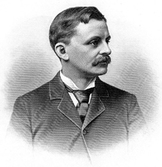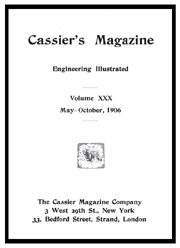Ethanol Has Been Recognized as the Superior Engine Fuel for Over 100 Years
 |
 Marc Rauch |
Exec. Vice President/Co-Publisher
THE AUTO CHANNEL
Elihu Thompson is a man who has been almost forgotten by history. When recalling the great inventors and innovators of the era that revolutionized the world with mechanical and technological marvels, you never hear his name alongside Edison, Bell, Ford, Carver, Marconi, Tesla, Wright brothers, Morse, Pasteur, Nobel, Diesel, and Farnsworth. But Elihu Thompson was equal in credentials and accomplishments to any of these forenamed people. He held more than 700 patents, merged his company with Thomas Edison's firm to become Gneral Electric, and he served as president of MIT from 1920 to 1923.
 Elihu Thompson |
Cassier's Magazine was a leading technology journal of the day (published in London). In the volume dated May-October 1906, the publication printed the text of Thompson's congressional testimony. In the same edition of Cassier's magazine is an article written by Thompson that expands on his congressional testimony. Here's the complete text of the two articles:
Professor Elihu Thomson, before the U. S. Congressional Ways and Means Committee on Free Industrial Alcohol - 1906
GASOLINE as well as kerosene has the great disadvantage that it floats upon the water and is distributed by water. It is a well-known fact that it is commercially useless to attempt to extinguish burning gasoline or kerosene by water alone. The use of water may, in fact, be a positive disadvantage in floating the burning material over considerable places in spreading fire. Not so with alcohol, which mixes with water in all portions, and which is at once diluted and prevented from remaining combustible.
We have recently tested at the Lynn works of the General Electric Company a Deutz alcohol engine, a type of engine made in Germany especially for use with alcohol, and the results have been such as to prove without doubt the entire suitability of alcohol, if cheap enough, as a fuel for internal combustion engines. This particular engine is to be sent to the island of Cuba and coupled to a dynamo for lighting. It will be operated with the cheap Cuban alcohol, which is, I am informed, sold there at about 12 to 15 cents per gallon. A few gallons of this alcohol were obtained and used in our tests here, and it was found to be a high-grade spirit, containing 94 per cent, alcohol by volume and 6 per cent, of water, or about 91 per cent, alcohol by weight.
 |
The exhaust gases from the alcohol engine carry off less heat. They are cooler gases. It is well known that the exhaust gases from a gasoline of kerosene engine are liable to be very objectionable on account of the odour. In our tests of the Deutz alcohol engine there was absolutely no such objection with alcohol fuel, the exhaust gases being slightly odorous, or nearly inodorous, but what odour there was, was not of a disagreeable character.
There is just now the beginning of a large development in the application of the internal combustion engine to the propulsion of railroad cars on short lines as feeders to the main lines. In this case an ordinary passenger car is equipped with a power compartment at one end, in which there will be installed an engine of, say, 200 horse-power of the internal combustion or explosion type. The growth of such a system is liable to be hampered in the near future by the cost of gasoline as a fuel, and the difficulties of using kerosene are still quite considerable. Especially is the exhaust likely to be offensive. In this case alcohol, which could be produced in unlimited amount, could be substituted.
It may be mentioned, in conclusion, that the efficiency,—that is, the ratio of the conversion of the heat units contained in the fuel into power,—is probably higher in the alcohol engine than in engines operated with any other combustible, and doubtless, on account of the comparative newness of the alcohol engines, there is still room for improvement in this respect.
ALCOHOL AND THE FUTURE OF THE POWER PROBLEM
By Elihu Thomson
page 310, same publication.
Recent legislation in the United States, by which denaturized alcohol may henceforth be produced free from taxation, has at once helped to make alcohol an important factor in the fuel problem. Already the lighter oils, for internal combustion engine use, largely through the enormously increased consumption in automobiles and motor boats, have given evidence of coming scarcity and advancing price, and for these alone, not counting multifarious other fuel uses, alcohol will be an excellent and readily available substitute.—The Editor.
Modern civilization is based upon the use of power,—upon engines of one type or another. In large measure the power is de rived from fuel. In cooler climates our comfort in winter is to a great extent a question of cheap fuel, while the various processes, such as the smelting and working of metals, the making of glass, the baking of porcelain, and so on, are factors in the gradual exhaustion of available combustibles,—coal, peat, oil. gas and wood of the forests.
Practically our whole problem of over-sea transportation is a fuel problem. Our land transportation is the same to an almost equal extent. Occasionally a water-power is avail able, to furnish, through the agency of electricity, the energy required for a railway, but the coal or oil-consuming locomotive will, doubtless, hold its own for a long time, except in the most densely populated districts. Where electric locomotives or trains are used, the power station will still depend in most cases upon fuel.
The population of the world and the expenditure of fuel for heat, light, and power steadily rises. A time must come when, under the continued and increasing drain, the cost of fuel will be increased, and the available supply diminished, until the advancing cost due to scarcity and distance of haul will at last check the consumption. Our heating in winter is a peculiarly wasteful process. Our buildings leak heat all over. We consume enormous amounts of fuel to maintain temperature conditions which are worse than wasteful. We oftentimes maintain temperatures indoors in winter in excess of those we seek in summer when we flee the city.
In our heating and ventilating systems we assume that when we discharge the air we must discharge it hot, and take in fresh, cold air, giving it fresh heat from fresh fuel. This is all wrong. What we will be compelled to do when our fuel cost is increased will be to transfer the heat from the escaping warm air to the cold supply by a system of re generation, supplemented by a construction of buildings which will cut off heat leakage and waste from that cause. In this way the air leaving a building will pass through a structure like a regenerator and will there deliver its heat to the incoming fresh air. Such regenerators can work at quite high efficiencies. The regenerating system will also be applied more extensively than at present to furnace processes, and waste furnace heat will be conserved for various uses.
But when all this and more is done the fuel question will still exist. The crisis, though delayed, must assuredly come. It avails little to say that in China there is coal to supply the world for hundreds, if not thousands, of years. We may not control that supply; the cost of trans porting it may make its use almost prohibitive.
Our fuel supply is the result of solar radiation in the geological past. Energy of the sun was stored in the earth millions of years ago. Our water-powers are the result of solar radiation in the present; the water evaporated . from the tropic seas is deposited on the cooler heights of land, and we incidentally use a small fraction of the energy play involved.
Solar radiation must continue to be the source of our power and heat. The growing plant can, by cultivation in the favoured districts, be encouraged to assimilate, so to speak, the solar energy. We already have the timber of the forests, the brush wood, the straw of the wheat field.
The ideal fuel, however, is, undoubtedly, liquid fuel of a nature to be readily vapourized. If the liquid be of a limpid, non-viscous character, the difficulties found in pipe-line transportation with the thick fuel oils will not stand in the way of such transportation and distribution.
Fortunately, we have in ethyl alcohol an ideal fuel,—colourless, limpid, of moderate boiling point, about 50 degrees below that of water, non- ' freezing, burning without smoke, mixing with water in all proportions, and, therefore, its flame extinguished by water, cleanly, drying off completely when spilled, not attacking rubber gaskets or packings, and non-corrosive for metal tanks and holders.
The fact that its flame is bluish, or so-called non-luminous, means that the flame is almost devoid of free carbon particles, with their intense heat-radiating power, a fact of considerable importance. When
gasoline or heavy oils are burning, the flame, loaded with free carbon or soot, radiates heat to such a degree that it is not possible to approach near the conflagration, and combustible surroundings are readily fired by pure radiation of heat.
The production of alcohol on a large scale is very simple, and the raw materials already exist in considerable variety. All saccharine or starchy growths are available. Saccharine wastes are now largely used in Cuba for alcohol production. At present it is said that the low grades of molasses can be delivered at American coast cities at about three cents per gallon. About three gallons of this crude product will be required to produce a gallon of re fined spirit, or 90 per cent, alcohol, and the cost of production may be estimated at from three to four cents. making the cost of the alcohol per gallon about twelve cents.
This alcohol will, in a properly organized engine, equal, volume for volume, gasoline now sold at a much higher price, in producing power. Even in the immediate future, then, it is evident that alcohol has a large field of usefulness. The farmer need not depend on wood, coal, or oil for his power. His agricultural wastes will furnish it. His fields need only receive the sunshine, and be given sufficient water, and thence any crop yielding starch or sugar, however unmarketable other wise, may be made the source of power, light, and heat.
The use of alcohol as a fuel, and as a source of power, will grow gradually. It would be idle to look for any sudden revolution in methods. It would, in fact, be very undesirable. Revolutions are destructive. Evolution, a slower process, is constructive. Gradually a system of production and distribution must be evolved, even for present needs.
But when we extend our vision into the far future, we can only speak of possibilities or probabilities. There is always a possibility of new discoveries modifying conditions to such an extent that our best present judgment may be in error. But assuming that increasing scarcity and cost of mineral fuels will gradually stimulate the selection and use of substitutes, it seems reasonable to predict that the one substitute which possesses the most desirable qualities is ethyl alcohol. The amount that can be produced is practically un limited.
A very important fact distinguishing alcohol production by agriculture from the production and shipment out of the land of food products, meat, etc., or even wood, is that in the former the land is not impoverished, as the mineral and nitrogenous matters can be returned to it, while in the. food and wood carried away the richness of the land is passing away, too.
Alcohol contains only carbon, hydrogen, and oxygen, all of which come from the air itself. The trans formation is begun in the carbonic acid and water of the air reaching the growing plant under the influence of sunshine, and completed in the fermenting vat and the still under human direction. Vigorous plant growth is a cooling process; solar energy is rendered latent or potential. It would even be possible to calculate from the fuel value of any growth or crop the proportion of the solar energy so stored up. Fermentation renders the energy stored more available, and distillation finally yields a concentrated product.
It is not unreasonable to expect that, in large engines of the internal combustion type when highly developed, we may attain efficiencies of 30 to 40 per cent. This means that of the heat units potential in the fuel, and liberated when it is burned with the oxygen of the air. about one-third may be converted into available power. It may even be that future invention will carry this proportion up to about one-half. With alcohol at a cost of ten cents a gallon,—a price even now realized in Cuba,— the cost of the fuel per kilowatt-hour would be about one cent and a quarter on an assumed efficiency of 33 per cent, in the engine.
It is not to be imagined that where coal or oil can be obtained at any thing like the present costs there is at present any possibility of their re placement. Neither is it likely that water-power, developed under favourable conditions, can ever have as a rival artificially produced fuel.
But inasmuch as the fuel cost is only a relatively small fraction of the total cost of operation of a great system of distribution, such as that of an electric lighting plant or rail way, it is evident that, considering the great convenience and adaptability of the alcohol vapour internal combustion engine, a wide field may open for its application, as the cost of the fuel alone is a relatively unimportant item. Certain it is, that for isolated small powers the alcohol mo tor can soon be used with convenience and economy in America, following the recent legislation there, removing the onerous tax.
As to the more distant future period, we need have no misgiving. We are assured that mankind, by the introduction of methods of economizing heat, and by artificially produced liquid fuel, will be able to maintain those activities demanding heat and power until "the sun him self grows dim with age. and nature sinks in years."
SEE ALSO:
• Life As We Might Have Known It: What If Ethanol Was Our Primary Engine Fuel
• The Rise & Fall of General Motors and the Subjugation of the Industrialized World
 |
For a lot more information about ethanol fuel you can read my 641-page book, THE ETHANOL PAPERS. It's available to read online for free by CLICKING HERE.


